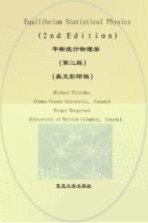图书介绍
平衡统计物理学 第2版 英文影印版PDF|Epub|txt|kindle电子书版本网盘下载

- (加)普里斯科著 著
- 出版社: 上海:复旦大学出版社
- ISBN:7309052005
- 出版时间:2006
- 标注页数:520页
- 文件大小:135MB
- 文件页数:549页
- 主题词:平衡状态(热力学)-统计物理学-研究生-教学参考资料-英文
PDF下载
下载说明
平衡统计物理学 第2版 英文影印版PDF格式电子书版下载
下载的文件为RAR压缩包。需要使用解压软件进行解压得到PDF格式图书。建议使用BT下载工具Free Download Manager进行下载,简称FDM(免费,没有广告,支持多平台)。本站资源全部打包为BT种子。所以需要使用专业的BT下载软件进行下载。如BitComet qBittorrent uTorrent等BT下载工具。迅雷目前由于本站不是热门资源。不推荐使用!后期资源热门了。安装了迅雷也可以迅雷进行下载!
(文件页数 要大于 标注页数,上中下等多册电子书除外)
注意:本站所有压缩包均有解压码: 点击下载压缩包解压工具
图书目录
1 Review of Thermodynamics1
1.1 State Variables and Equations of State2
1.2 Laws of Thermodynamics3
1.2.1 First law4
1.2.2 Second law5
1.3 Thermodynamic Potentials10
1.4 Gibbs-Duhem and Maxwell Relations13
1.5 Response Functions15
1.6 Conditions for Equilibrium and Stability17
1.7 Thermodynamics of Phase Transitions19
1.8 Problems23
2 Statistical Ensembles29
2.1 Isolated Systems:MicrocanonicalEnsemble30
2.2 Systems at Fixed Temperature:Canonical Ensemble35
2.3 Grand Canonical Ensemble40
2.4 Quantum Statistics43
2.4.1 Harmonic oscillator44
2.4.2 Noninteracting fermions44
2.4.3 Noninteracting bosons45
2.4.4 Density matrix46
2.5 Maximum Entropy Principle48
2.6 Thermodynamic Variational Principles51
2.7 Problems53
3 Mean Field and Landau Theory61
3.1 Mean Field Theory of the Ising Model63
3.2 Bragg-Williams Approximation65
3.3 Order Disorder Transition69
3.4 Bethe Approximation74
3.5 Critical Behavior of Mean Field Theories77
3.6 Ising Chain:Exact Solution80
3.7 Landau Theory of Phase Transitions86
3.8 Example of Symmetry Considerations:Maier-Saupe Model89
3.9 Landau Theory of Tricritical Points96
3.10 Landau-Ginzburg Theory for Fluctuations103
3.11 Multicomponent Order Parameters:n-Vector Model107
3.12 Mean Field Theory of Fluids:Van der Waals Approach109
3.13 Problems115
4 Dense Gases and Liquids123
4.1 Virial Expansion125
4.2 Distribution Functions131
4.2.1 Pair correlation function131
4.2.2 BBGKY hierarchy137
4.2.3 Ornstein-Zernike equation138
4.3 Perturbation Theory141
4.4 Inhomogeneous Liquids143
4.4.1 Liquid-vapor interface143
4.4.2 Capillary waves149
4.5 Density-Functional Theory151
4.5.1 Functional differentiation151
4.5.2 Free-energy functionals and correlation functions153
4.5.3 Applications159
4.6 Problems161
5 Critical Phenomena Ⅰ163
5.1 Ising Model in Two Dimensions164
5.1.1 Transfer matrix164
5.1.2 Transformation to an interacting fermion problem168
5.1.3 Calculation of eigenvalues171
5.1.4 Thermodynamic functions174
5.1.5 Concluding remarks179
5.2 Series Expansions179
5.2.1 High-temperature expansions180
5.2.2 Low-temperature expansions186
5.2.3 Analysis of series186
5.3 Scaling191
5.3.1 Thermodynamic considerations191
5.3.2 Scaling hypothesis192
5.3.3 Kadanoff block spins195
5.4 Finite-Size Scaling199
5.5 Universality204
5.6 Kosterlitz-Thouless Transition206
5.7 Problems214
6 Critical Phenomena Ⅱ:The Renormalization Group217
6.1 The Ising Chain Revisited218
6.2 Fixed Points222
6.3 Position Space Renormalization:Cumulant Method228
6.3.1 First-order approximation232
6.3.2 Second-order approximation234
6.4 Other Position Space RenormalizationGroup Methods237
6.4.1 Finite lattice methods237
6.4.2 Adsorbed monolayers:Ising antiferromagnet238
6.4.3 Monte Carlo renormalization243
6.5 Phenomenological Renormalization Group246
6.6 The ε-Expansion249
6.6.1 The Gaussian model251
6.6.2 The S4 model255
6.6.3 Critical exponents to order ε258
6.6.4 Conclusion264
6.7 Problems265
7 Simulations271
7.1 Molecular Dynamics272
7.2 Monte Carlo Method277
7.2.1 Markov processes277
7.2.2 Detailed balance and the Metropolis algorithm279
7.2.3 Histogram methods282
7.3 Data Analysis284
7.3.1 Fluctuations284
7.3.2 Error estimates286
7.3.3 Extrapolation to the thermodynamic limit287
7.4 The Hopfield Model of Neural Nets290
7.5 Simulated Quenching and Annealing295
7.6 Problems298
8 Polymers and Membranes301
8.1 Linear Polymers302
8.1.1 The freely jointed chain304
8.1.2 The Gaussian chain307
8.2 Excluded Volume Effects:Flory Theory309
8.3 Polymers and the n-Vector Model313
8.4 Dense Polymer Solutions317
8.5 Membranes323
8.5.1 Phantom membranes324
8.5.2 Self-avoiding membranes327
8.5.3 Liquid membranes332
8.6 Problems336
9 Quantum Fluids339
9.1 Bose Condensation339
9.2 Superfluidity347
9.2.1 Qualitative features of superfluidity347
9.2.2 Bogoliubov theory of the 4He excitation spectrum356
9.3 Superconductivity359
9.3.1 Cooper problem360
9.3.2 BCS ground state361
9.3.3 Finite-temperature BCS theory365
9.3.4 Landau-Ginzburg theory of superconductivity369
9.4 Problems373
10 Linear Response Theory377
10.1 Exact Results378
10.1.1 Generalized susceptibility and the structure factor378
10.1.2 Thermodynamic properties385
10.1.3 Sum rules and inequalities386
10.2 Mean Field Response388
10.2.1 Dielectric function of the electron gas389
10.2.2 Weakly interacting Bose gas391
10.2.3 Excitations of the Heisenberg ferromagnet393
10.2.4 Screening and plasmons396
10.2.5 Exchange and correlation energy402
10.2.6 Phonons in metals404
10.3 Entropy Production,the Kubo Formula,and the Onsager Rela-tions for Transport Coefficients406
10.3.1 Kubo formula406
10.3.2 Entropy production and generalized currents and forces408
10.3.3 Microscopic reversibility:Onsager relations410
10.4 The Boltzmann Equation414
10.4.1 Fields,drift and collisions414
10.4.2 DC conductivity of a metal417
10.4.3 Thermal conductivity and thermoelectric effects419
10.5 Problems423
11 Disordered Systems429
11.1 Single-Particle States in Disordered Systems431
11.1.1 Electron states in one dimension432
11.1.2 Transfer matrix433
11.1.3 Localization in three dimensions439
11.1.4 Density of states441
11.2 Percolation446
11.2.1 Scaling theory of percolation448
11.2.2 Series expansions and renormalization group451
11.2.3 Conclusion453
11.3 Phase Transitions in Disordered Materials454
11.3.1 Statistical formalism and the replica trick455
11.3.2 Nature of phase transitions458
11.4 Strongly Disordered Systems463
11.4.1 Molecular glasses463
11.4.2 Spin glasses465
11.4.3 Sherrington-Kirkpatrick model470
11.5 Problems476
Appendix:Occupation Number Representation481
Bibliography495
Index511